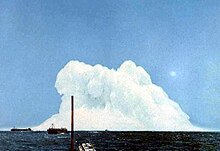Mark 90 nuclear bomb

The Mark 90 nuclear bomb, given the nickname "Betty", was a cold war nuclear depth charge, developed by the United States in 1952.
It had a length of 10 ft 2 in (3.10 m), a diameter of 2 ft 7.5 in (0.80 m), and a weight of 1,243 lb (564 kg), and it carried a Mark 7 nuclear warhead with a yield of 32 kilotons. Its purpose was to serve as an anti-submarine weapon for the United States Navy.
A test of the Mark 90 was conducted in 1955, as Operation Wigwam.
All units were withdrawn from service by 1960.
Accident
On September 25, 1959, a United States Navy Martin P5M-2 Marlin (BuNo 135540, SG tailcode, '6', of VP-50) was patrolling out of NAS Whidbey Island when it was forced to ditch in the Pacific Ocean, about 100 miles west of the Washington-Oregon border.
A Mark 90 depth charge casing was lost and never recovered, but it was not fitted with an active warhead.[citation needed] The ten crew members were rescued by the US Coast Guard, after ten hours in a raft. The press was not notified at the time.[1]
References
- ^ Gibson, James N. Nuclear Weapons of the United States – An Illustrated History. Atglen, PA: Schiffer Publishing Ltd., 1996, LCCN 96-67282, ISBN 0-7643-0063-6, Chapter 12, "Nuclear Anti-Submarine Weapons", p. 214.
